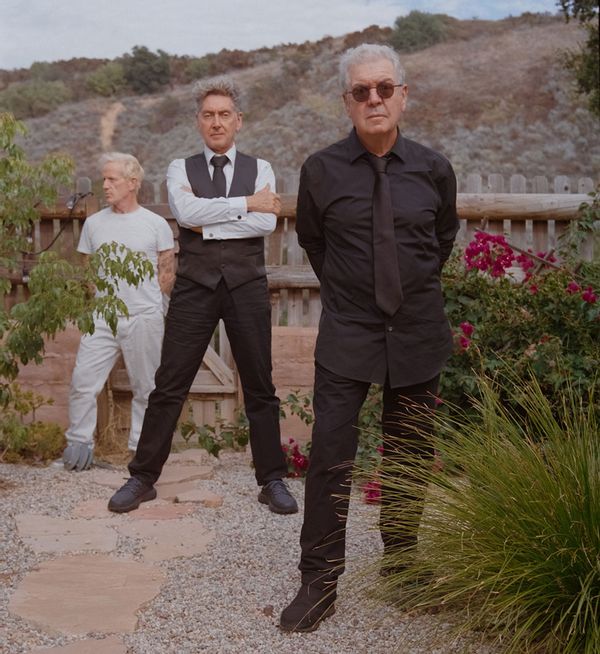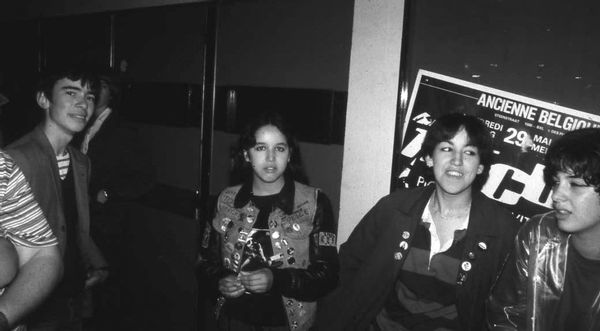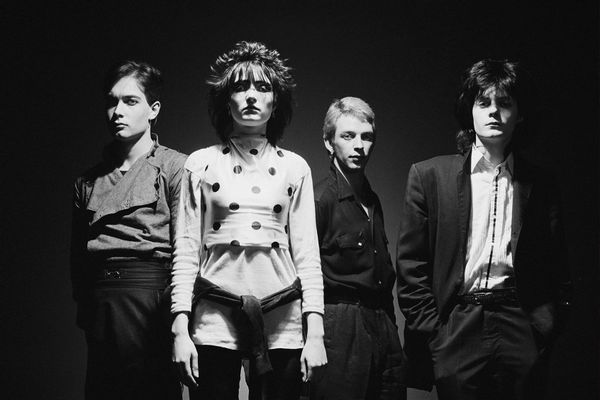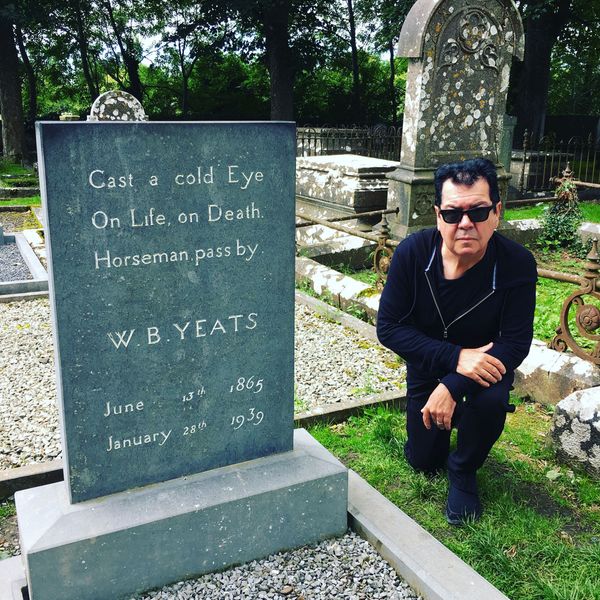
Lol Tolhurst’s “Goth: A History” succeeds at what’s often thought of as an impossible task: defining the roots, influences and impact of goth. Of course, the musician knows of which he speaks. As the co-founder and first drummer of the Cure, Tolhurst was an integral part of the musical genre’s rise in late-’70s and early-’80s England, though he might not have admitted it at the time.
“Despite our passionate insistence that the Cure was not a Goth group, the Cure was very much a Goth group,” Tolhurst writes in “Goth.”
Buoyed by research conducted by his son, Gray (who happens to play in a fantastically gloomy band of his own, Topographies) “Goth” examines the literary and musical influences on goth, including Sylvia Plath, T.S. Eliot, David Bowie, Alice Cooper and the Doors. The book then goes on to explore the Cure and their contemporaries — Bauhaus, Joy Division, Siouxsie and the Banshees — before tracing goth’s impact through the modern day’s music, scenes and fashion. “Goth” is meticulous and detailed, with the kind of smart, informed perspectives that do justice to the often-maligned subculture.
“Goth” grew out of the book tour for Tolhurst’s 2016 memoir, “Cured: The Tale of Two Imaginary Boys,” which resembled a concert tour more than anything. “Most authors don't really do more than about 10 [events], according to my agent,” he said. “But I did about 300. I went all over America. I went all over quite a bit of Europe and I went to South America — I went to Peru and Argentina and Chile.”
At these events, he met countless fans who expressed curiosity about “what the experience of growing up like that was, how it became that way, how goth came about,” Tolhurst says. He points out that photos of seminal places and scenes don’t necessarily exist — and things like notorious London goth club night the Batcave were different from what people might think.
“What I remembered in The Batcave was that yes, there were people that looked like what we would think are goths,” Tolhurst says, “but there were also a lot of different kinds of people. It didn't exclude anybody. If you had the money at the door, you could come in. It wasn't like, ‘Oh, you don't look goth enough, so you can't come in.’”

Obviously with your background, this book concept is perfect.
What I wanted to do with this book is explain how [goth] came about. The hardest part of writing it was the first six months trying to find what my model was going to be. I thought, “Well, I can't just write something that's another adjunct to the memoir,” which it kind of is as well. But I've got to write about other people. I've got to write about other situations that are not pertinent completely to me. How do I do that?
I'd been reading a lot of Joan Didion, and I really liked the way that she approached talking about events that are news stories. She made them come alive in a way that made them more than that, and so I tried to channel her spirits a bit in the writing of the stories. I remember reading a story she wrote about a dentist in San Bernardino; his wife killed him. And the way she described it, it was like a noir novel. It was very dark. Once I had decided, "OK, there's where I can get the inspiration for it," then everything else was much simpler. Everything else is just going out and getting the facts.
I didn't even have to do that because my son Gray was my researcher. At the beginning, I said to my agent, "I've got this idea for a book, but I really don't want to do the research because it's like homework, and I don't want to do that. I want to write the stories." My son has an MFA in creative writing, so I said, "OK, time to pay the old man back for all the stuff that I've had to fork out for.”
But I told Gray, "OK so I'll be telling you what I need and what I want you to research for me, but I'm not your boss, okay?" I didn't want me having to chase him. It worked out fine. Some fathers and sons bond over football or whatever, that we bonded over writing this book, so it was great.

I had the idea of what it would be for the beginning, and I knew the middle part, which is what happened in that time in the '80s, but what I needed help with really was understanding where it's gone since. He was very instrumental in that part because a lot of people my age, they will say to me, conspiratorially, “There's no good music nowadays." And I say, "No, you're wrong. You're wrong. You just have forgotten where to find it. You don't know where to look because you've become older and you've lost the connections to it."
But I have a perfect connection because I have him. I just call him and say, "Gray, what should I be listening to? What's good? What's good out there?" He would introduce me to people. That was very helpful to me, because it wasn't always obvious to me where the [goth] thread had gone. I kind of knew, because like I always tell people, I've spent 40 years traveling around America and I can pretty much go into any small town and spot the people who are going to be goths. Like the five or six kids, I can spot them straight away. They have certain tendencies.
What I was looking for in the stuff that Gray showed me was like, where does this come from? Where's the genesis from it? It adapts, because I think like goth in general is malleable, but it stays true to certain tenets. That's really what I was looking for, so he was very useful for that.
“Goth” came off as approaching things from more of an anthropological perspective, which I think makes total sense and fits—because you're right, there are the core tenets and over time, everything has evolved, but there's certain literary and musical touchstones that are really universal. The book really dug into that and underscored these facts.
Well, it's going to make you laugh then, because Gray's B.A. was in anthropology. That was his first love, and then he decided, “I think I love words more.” That's what he told me: "I love the stories. I don't love the research particularly." But unfortunately, he had to do the research for me, but that was good, because his mind was trained in how to do research. Me, I could research things, but it wouldn't be the same.
And it's all about how the connections are made and how they evolve because things don't happen out of the blue. There's an evolution to go along with it all. My role in all of this was to connect the dots, really, and just show people this is where it comes from. You might think it comes from "Edward Scissorhands." And maybe there's some connections, because I know Tim [Burton] and I know where his ideas are fermented from, but there's other stuff that you might not be aware of. It’s like, “OK, so this is my journey. This is how I got to this point. These are the touchstones that I took with me.”

Yeah. I find it fascinating. I moved to California 30 years ago. I live quite close to the beach — not on the beach, but I live quite close. If you walk down onto Venice Beach, there's a police station right there on the beach, a police department, and it has a wall surrounding it. The wall is the poetry wall, and it has Morrison's poetry on the wall inscribed in it, which is amazing. It's ironic it's surrounding the police station, but it's still there. The whole feeling is still there. If you walk along the Venice Boardwalk on a Sunday, if you close your eyes and squint a bit, it could be the 1970s still. You open your eyes up and you see things that definitely weren't around then, but it's still got that same atmosphere, so I wanted to join the dots for people and show them where things germinated from.
As you were writing and then putting everything together, what sort of surprises did you discover? Or were there any things where you discovered connections you maybe didn't realize or expected until you were really digging into things?
[Pauses.] Yeah. I don't know. That's almost an impossible question for me because I think I spend most of my spare time looking for the connections. [Laughs.] It's like, if it hasn't come up, I'd probably think it's come up before and tried to connect stuff. I don't know.
What was interesting for me was talking to some of my contemporaries. I know most of them, but I don't know everybody, and seeing where their touchstones came from. We share lots of commonalities. I know Kevin [Haskins] quite well in Bauhaus, but I didn't know his brother [David J] very well. I sent him initially a big questionnaire, and it was interesting that although we hadn't really crossed paths that much there’s a similar genesis.
A few years ago, when people first started looking around the world on Google Earth or whatever, and they would go, "Oh, I can look at any streets in the world and go around." I did what I'm sure everybody does: I thought, “I'll go back and have a look about where I grew up and all those places, and I'll go to all the little secret places of my teenage years and childhood. And it blew my mind because after I finished doing that, I called Robert [Smith] up and I said, "You know what? It is absolutely no surprise to me that the music we wrote came out this way because it's there in the streets, in the dark, dank English countryside. It's there."
That's what we wrote. We wrote what we lived in and what we saw. It shouldn't be a surprise, but it was to me, and I realized, well, I could use that angle for a lot of other people, like for Joy Division. Definitely where they grew up, that huge monolithic projects that was outside of the Factory club with thousands of people living in this brutalist nightmare — I got it straight away. I only had to see that and go, “Yeah, OK, that makes sense." They always say that if you're a writer, you should write what you know, so I try generally to do that. But these things I didn't know — but when I saw them, I knew them. Does that make sense?
That totally makes sense.
I could connect with it. I think it's very true for musicians as well. If you know where they come from, if you know from where their images come from, there's something else that goes along with that. If you know those things that were there at the beginning, that's what informs it all the way along.
[A few years ago Gray] sent me the test pressing of the [first Topographies] album and said, "Dad, would you have a listen to it and tell me if it's OK?" I said, "Sure." But then I panicked, because like most middle-aged guys, my music is either on this [computer] or a CD. At the time, I didn't have a turntable, so I called a friend of mine up, he's a DJ [and] said, "What's the best turntable? Tell me the turntable I have to get."
I went out and I got one, and I listened and said, "Yeah, it's great. Everything's good." And then I had a box in the corner of my teenage records, the ones that Gray hadn't pilfered over the years [for] his collection. I started playing them when I was working on something else. That was mind-blowing as well, because in that box was everything that The Cure, became, you know?
Wow.
The connections weren't obvious, either. They weren't like, "Oh, OK, maybe there's some Buzzcocks and maybe you can see, well, there's a connection there with the early Cure." No, there were very, very striking examples of how to play different things [that] like osmosis, just come into us.
My friend James Murphy said to me, "You know, when you start first playing music, initially, you write songs like the people that you like." If you grew up liking The Smiths, you try and write a Smiths song and that becomes sort of your task initially. What happens is you get it wrong because you can't be them, or you can't be those people, because you have a different experience. You can't play in the same way.
And the way you get it wrong is what becomes your sound—and he's absolutely right. If I think about who we were trying to channel when we first started, we don't sound like them at all. The Cure doesn't sound like them at all. But I can see where the connections are now. It's the way we got it wrong. We couldn't play that way, or we didn't know what they were doing here, so we did our version of it, and that becomes your thing. The same must be true in writing as well.
I am not Joan Didion, and I don't think I ever would be, but I channeled the idea of how she would write and that was what was interesting to me. Obviously, the other literary things I put in the book, especially Sylvia Plath. I'd always loved her writing, but even more than the poetry, I love "The Bell Jar." It speaks to me of angst, and I understand where that comes from. Like I say in the book, although it's something rather different from my own [experience] — she wasn't a teenage boy growing up in England — I can transfer that to my own experiences and understand the feelings. And she writes so well about those things — that was a very good touchstone for me.

It's true. One of the quotes in my book [is] about Joe Strummer, and I said, "Joe Strummer saved my life” — not literally, but what Joe did helped me to become a man, and they wanted to know about that.
This is going to sound anthropological as well. But [in other societies] there are ceremonies [to mark] going from being a youth, a teenager, into adulthood. And we don't really have those in modern society. They've sort of gone away. I realized that becoming a punk was my ceremony. That was teaching me how to be out in the world, and so that's what I meant.
I was in my 50s when I started to write seriously. It was amazing because it is anthropology. I'm digging up the past to find out why things happened to explain it to myself more than anything else. That might sound a bit narcissistic, but I don't mean it in that way. I mean it more in a way to understand from where I've come to be able to utilize it now and maybe pass that on. I don't mean it to sound pompous, but to have that there so there's some kind of record of like, “Oh yes, well, this is how this happened, and this is what it produces.”
I think it's just something that happens as you get older, you start to see the little connections all over the world, which is actually a good part about getting old. Most of the parts about getting old are not good. My hearing's not as good as it was. There's more aches in the morning when I get up. But the good part is, you can actually start to see the whole picture much better.
That's what I was going to say: You have that perspective. And especially something like goth, a genre that has been mocked or misunderstood over the years, but is finally starting to get respect and some serious scholarship. We need the people who were there to chronicle it from the beginning. The Batcave was much different than maybe people think it is, and so you need to have that fuller picture so the historical record is more accurate.
One thing that intrigued me was like, say Mary Shelley with "Frankenstein." It blew my mind when I found out there was never a proper scholarly biography about her until the '80s. It's like, really? There's one of the most famous novels in the English language. Why was there not?
It's not the first thing that comes to mind, but my aim is to bring some of those things to the forefront and say, "Look, this is something that has influenced a lot of artistry and thought in the Western world for quite some time. You need to know where it comes from and how it came about." That makes it interesting to me.
Cathi Unsworth has written a book about goth, and I did an event with her in London a couple of weeks ago. She said to me she liked the fact that I had given it a name and owned the name of goth. She's more of a journalist than anything else, she said, "A lot of people seek to defang goth by making fun of it.” I think that's very true. If you can turn it into bats and coffins, then it's not scary.







